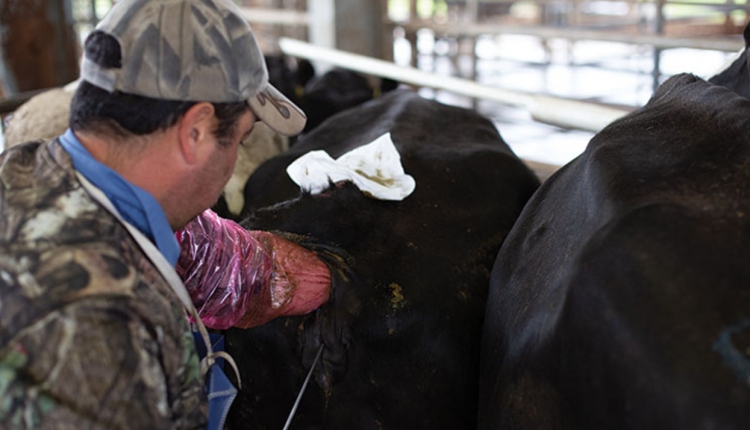The author is professor of animal sciences at Kansas State University, Manhattan.

Getting fresh cows off to a good start is important.
Many reproductive disorders are complex and have their root in fresh cow conditions.
A myth is a tradition or legend that attempts to express or explain a basic truth and is often accepted uncritically. These myths, traditions, and legends influence our thinking. At the same time, we recognize that not all information provided to us in person or electronically is worthy of our trust. So, how do we balance all this data?
Our minds should be open to new information, and our thinking should be influenced by new knowledge. With that in mind, a number of myths exist in our industry. Let's examine a few myths about cystic ovaries.
What are cystic ovaries?
By definition, cystic ovaries are follicle-like structures on the cow's ovary that are larger than 3 cm (1.1 inches) in diameter. Cystic ovaries come in two types:
1. follicular
2. luteal
Follicular cysts are soft in texture and can be easily popped by manual palpation per the rectum. A few cows having follicular cysts show estrus behavior at irregular intervals.
Luteal cysts are anovulatory luteinized follicles. They are thick-walled, more rubbery upon palpation. They resemble in function a normal corpus luteum (CL) because the thick wall is actual luteal tissue that secretes progesterone like a CL. The cavity in both types of cysts is fluid-filled.
Myths
There are a number of myths I have heard about cystic ovaries over the years. They include:
cystic ovaries are caused by energy imbalance
cysts are caused by an imbalance in micro minerals
cysts are caused by several unknown imbalances in nutrition
cystic ovaries are common in dairy herds
While these may be myths, there are some well-researched truths:
Truth No. 1
Follicular cysts occur most commonly between 15 and 45 days in milk, usually as large, thin-walled single cysts on one or both ovaries. Spontaneous recovery of cystic follicles occurs in nearly 50 percent of cows before A.I. breeding resumes by 60 days in milk.
Truth No. 2
Accurate differentiation of the two cyst types is difficult and next to impossible by palpation. This occurs partly because a newly forming CL has a fluid-filled cavity and "feels" (palpates) much like a cyst. Using transrectal ultrasound is the only way to make an accurate cowside diagnosis of cyst type.
Also, palpation of normal ovarian structures has its failings. Three studies in scientific literature compared diagnoses of CL with simultaneous blood sampling for progesterone concentrations. Only 80 percent of cows had high progesterone when the technicians claimed a CL was palpated in one or both of the ovaries. When technicians claimed no CL existed, about 25 to 30 percent of cows had high progesterone, indicating they failed to palpate a CL.
Truth No. 3
In my experience using ultrasound to diagnose pregnancy during the last 15 years, the luteal cyst is the most common cyst found in open cows. Many of these produce progesterone and are poorly formed CL with a large fluid cavity. It is rare to find a CL with a cavity in a pregnant cow at 30 to 32 days.
Truth No. 4
Cystic ovaries can be caused by feed ingredients that contain estrogen-like compounds known as isoflavones or phytoestrogens. Some of which are found in legumes (red clover), whole soybeans, and moldy feed.
Truth No. 5
No data exist on the economic impact of cystic ovaries to dairy producer's income. Since the advent of ultrasound to correctly diagnose cysts from other ovarian structures, the frequency of cysts has dropped (to fewer than 5 percent). Some have referred to cysts as a palpation disease because of their previous overdiagnosis by palpation per the rectum. This statement is not to incriminate our veterinary practioners in anyway, but to indicate that with the available tools before ultrasound, the diagnoses were often incorrect.
Truth No. 6
Specific nutrients or diet components have not been identified to cause cysts. The exception is the deficiency of ?-carotene and the reported rise in cysts of German cattle that was not substantiated by research conducted in the U.S.
Truth No. 7
Few cows become cystic and fail to respond to treatment. The most effective treatment for cysts is GnRH (Cystorelin, Factrel, and Fertagyl) or human chorionic gonadotropin (hCG marketed as Chorulon by Merck Animal Health).
I have observed greater success using hCG than GnRH to luteinize the cyst and then regress it some days later by injecting prostaglandin (estroPLAN, Estrumate, or Lutalyse). Where cows have multiple cysts, neither treatment is very effective. These cows are often culled.
Truth No. 8
Cysts are prone to recur in cows having a previous history. A number of studies reported that cystic ovarian disease has a low to moderate heritability (up to h2 = 0.43) in dairy cattle. Its incidence has been reduced in Sweden as a direct result of selecting against its occurrence by bull studs.
Truth No. 9
Occurrence of cysts rises with age in dairy cattle. Compared with cows of other age groups, cows 2 to 4 years of age are less likely to develop cysts, whereas cows 4 to 7 years old tended to be less likely to have cysts than cows aged 7 to 10 years old.
Truth No. 10
Most have concluded that neither high milk production in previous noncystic lactations nor high genetic potential for milk yield were risk factors for cystic ovaries. Estimates of genetic correlations between ovarian cyst and milk yield are inconsistent across lactations. The conclusion drawn from five studies was that high milk yield does not cause cystic ovaries in Holstein cows.
Truth No. 11
Most studies indicate that an endocrine imbalance may be the cause of ovarian cysts. This is because administration of exogenous estrogens and progestins, alone or in combination, have caused cysts to occur. Cysts can be induced by administering antiserum to LH or estrogen.
Possible causes of spontaneously forming ovarian cysts include:
1. defects in the response of the hypothalamic-pituitary axis to the positive feedback of estrogen
2. lack of receptors for LH and FSH in ovarian cystic follicles which can be restored by exogenous FSH
3. excess FSH overstimulating follicular development
4. inadequate pituitary LH to induce ovulation
5. partial failure of the mechanism controlling pituitary release of LH
6. deficiency in the synthesis or release of GnRH
It is a complex issue
Most reproductive disorders (dystocia, twinning, stillbirth, retained placenta, cystic ovaries, anovulation, infections of the reproductive tract, and abnormal health status) occur as a complex, rather than as a single, abnormality.
Cows with one disorder are at greater risk for other disorders, including metabolic ones. The literature indicates that measures to prevent occurrence of one disorder might reduce the risk and incidence of other related disorders, either directly or indirectly. The long-term cumulative effect of genetic selection against diseases might be useful to diminish their incidence.
Click here to return to the Reproduction E-Sources
120110_21

Many reproductive disorders are complex and have their root in fresh cow conditions.
A myth is a tradition or legend that attempts to express or explain a basic truth and is often accepted uncritically. These myths, traditions, and legends influence our thinking. At the same time, we recognize that not all information provided to us in person or electronically is worthy of our trust. So, how do we balance all this data?
Our minds should be open to new information, and our thinking should be influenced by new knowledge. With that in mind, a number of myths exist in our industry. Let's examine a few myths about cystic ovaries.
What are cystic ovaries?
By definition, cystic ovaries are follicle-like structures on the cow's ovary that are larger than 3 cm (1.1 inches) in diameter. Cystic ovaries come in two types:
1. follicular
2. luteal
Follicular cysts are soft in texture and can be easily popped by manual palpation per the rectum. A few cows having follicular cysts show estrus behavior at irregular intervals.
Luteal cysts are anovulatory luteinized follicles. They are thick-walled, more rubbery upon palpation. They resemble in function a normal corpus luteum (CL) because the thick wall is actual luteal tissue that secretes progesterone like a CL. The cavity in both types of cysts is fluid-filled.
Myths
There are a number of myths I have heard about cystic ovaries over the years. They include:
cystic ovaries are caused by energy imbalance
cysts are caused by an imbalance in micro minerals
cysts are caused by several unknown imbalances in nutrition
cystic ovaries are common in dairy herds
While these may be myths, there are some well-researched truths:
Truth No. 1
Follicular cysts occur most commonly between 15 and 45 days in milk, usually as large, thin-walled single cysts on one or both ovaries. Spontaneous recovery of cystic follicles occurs in nearly 50 percent of cows before A.I. breeding resumes by 60 days in milk.
Truth No. 2
Accurate differentiation of the two cyst types is difficult and next to impossible by palpation. This occurs partly because a newly forming CL has a fluid-filled cavity and "feels" (palpates) much like a cyst. Using transrectal ultrasound is the only way to make an accurate cowside diagnosis of cyst type.
Also, palpation of normal ovarian structures has its failings. Three studies in scientific literature compared diagnoses of CL with simultaneous blood sampling for progesterone concentrations. Only 80 percent of cows had high progesterone when the technicians claimed a CL was palpated in one or both of the ovaries. When technicians claimed no CL existed, about 25 to 30 percent of cows had high progesterone, indicating they failed to palpate a CL.
Truth No. 3
In my experience using ultrasound to diagnose pregnancy during the last 15 years, the luteal cyst is the most common cyst found in open cows. Many of these produce progesterone and are poorly formed CL with a large fluid cavity. It is rare to find a CL with a cavity in a pregnant cow at 30 to 32 days.
Truth No. 4
Cystic ovaries can be caused by feed ingredients that contain estrogen-like compounds known as isoflavones or phytoestrogens. Some of which are found in legumes (red clover), whole soybeans, and moldy feed.
Truth No. 5
No data exist on the economic impact of cystic ovaries to dairy producer's income. Since the advent of ultrasound to correctly diagnose cysts from other ovarian structures, the frequency of cysts has dropped (to fewer than 5 percent). Some have referred to cysts as a palpation disease because of their previous overdiagnosis by palpation per the rectum. This statement is not to incriminate our veterinary practioners in anyway, but to indicate that with the available tools before ultrasound, the diagnoses were often incorrect.
Truth No. 6
Specific nutrients or diet components have not been identified to cause cysts. The exception is the deficiency of ?-carotene and the reported rise in cysts of German cattle that was not substantiated by research conducted in the U.S.
Truth No. 7
Few cows become cystic and fail to respond to treatment. The most effective treatment for cysts is GnRH (Cystorelin, Factrel, and Fertagyl) or human chorionic gonadotropin (hCG marketed as Chorulon by Merck Animal Health).
I have observed greater success using hCG than GnRH to luteinize the cyst and then regress it some days later by injecting prostaglandin (estroPLAN, Estrumate, or Lutalyse). Where cows have multiple cysts, neither treatment is very effective. These cows are often culled.
Truth No. 8
Cysts are prone to recur in cows having a previous history. A number of studies reported that cystic ovarian disease has a low to moderate heritability (up to h2 = 0.43) in dairy cattle. Its incidence has been reduced in Sweden as a direct result of selecting against its occurrence by bull studs.
Truth No. 9
Occurrence of cysts rises with age in dairy cattle. Compared with cows of other age groups, cows 2 to 4 years of age are less likely to develop cysts, whereas cows 4 to 7 years old tended to be less likely to have cysts than cows aged 7 to 10 years old.
Truth No. 10
Most have concluded that neither high milk production in previous noncystic lactations nor high genetic potential for milk yield were risk factors for cystic ovaries. Estimates of genetic correlations between ovarian cyst and milk yield are inconsistent across lactations. The conclusion drawn from five studies was that high milk yield does not cause cystic ovaries in Holstein cows.
Truth No. 11
Most studies indicate that an endocrine imbalance may be the cause of ovarian cysts. This is because administration of exogenous estrogens and progestins, alone or in combination, have caused cysts to occur. Cysts can be induced by administering antiserum to LH or estrogen.
Possible causes of spontaneously forming ovarian cysts include:
1. defects in the response of the hypothalamic-pituitary axis to the positive feedback of estrogen
2. lack of receptors for LH and FSH in ovarian cystic follicles which can be restored by exogenous FSH
3. excess FSH overstimulating follicular development
4. inadequate pituitary LH to induce ovulation
5. partial failure of the mechanism controlling pituitary release of LH
6. deficiency in the synthesis or release of GnRH
It is a complex issue
Most reproductive disorders (dystocia, twinning, stillbirth, retained placenta, cystic ovaries, anovulation, infections of the reproductive tract, and abnormal health status) occur as a complex, rather than as a single, abnormality.
Cows with one disorder are at greater risk for other disorders, including metabolic ones. The literature indicates that measures to prevent occurrence of one disorder might reduce the risk and incidence of other related disorders, either directly or indirectly. The long-term cumulative effect of genetic selection against diseases might be useful to diminish their incidence.
120110_21










